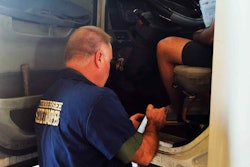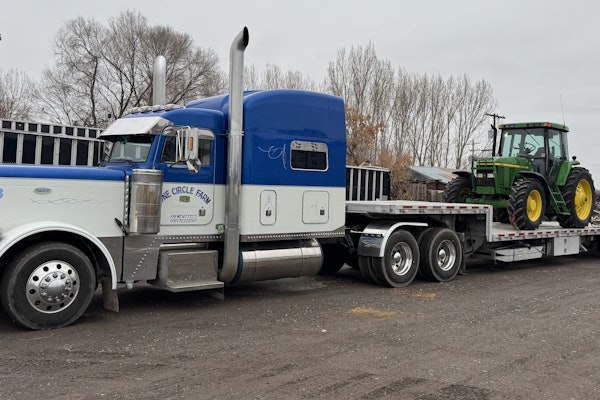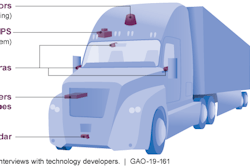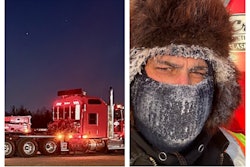The electronic logging device mandate is less than a year old, but the Federal Motor Carrier Safety Administration already is claiming its success in improving hours of service compliance.
“Overall HOS violations per inspection are half of what they were previously,” says Duane DeBruyne, FMCSA’s acting director of internal affairs.
The agency released a chart to that effect in June, comparing data from before and after the mandate took effect Dec. 18.
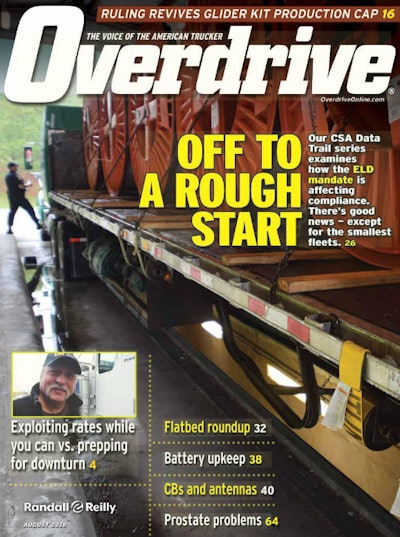 This series of reports and data analysis is also available in the August print edition of Overdrive. Access a digital version of the print issue via this link.
This series of reports and data analysis is also available in the August print edition of Overdrive. Access a digital version of the print issue via this link.Furthermore, the percentage of total inspections that resulted in an HOS violation after the beginning of the hard enforcement of the ELD mandate in April was nearly half of what it had been in April 2017. FMCSA excluded from its accounting violations that were specific to functions of ELDs and automatic onboard recording devices.
“When looking at hours of service violations, the agency is specifically focusing on those violations of the daily and weekly limits,” DeBruyne says.
The decline may be less dramatic than what’s claimed in the for-hire trucking population. Overdrive’s annual CSA’s Data Trail analysis, conducted with sister company RigDig Business Intelligence, shows a year-over-year drop of 42,382 violations, or 39 percent, in the so-called soft enforcement period of December to April when compared to the same months a year earlier.

At the same time, if you excise the more than 24,000 violations coded 395.22(a) for carriers not having an ELD during the soft enforcement period, the falloff in hours violations appears even more dramatic than that claimed by FMCSA: a 62 percent drop in violations of the bedrock HOS rules. Those 395.22(a) violations, had full enforcement been in force, would have been “no log book” violations for not running with an ELD when required.
 *Minus AOBRD-related violations
*Minus AOBRD-related violations**Minus both AOBRD- and ELD-related violations, though the number does include 24,742 violations of CFR 395.22(a), the parking place for no-ELD violations that inspectors were using prior to April 1 in order to exclude those violations from carrier CSA scores during the soft enforcement period. Remove those, which otherwise would have been 395.8(a) (no log book) violations if hard enforcement was in place, and it’s clear that ELDs are delivering a dramatic decline in bedrock hours violations to fleets of all sizes.
Mid-size to larger carriers, at once, appear to be benefiting the most from increased compliance. Carriers with one to four trucks, whose hours violations as a share of all violations has been falling for years, claimed a larger percentage for the first time in years for the first four months of this year.
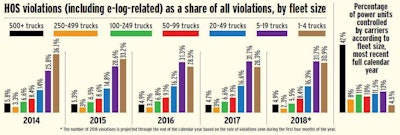 (Click through the image for a larger view.) Though fleets of one to four trucks control the smallest share of total power units among these categories of for-hire fleet sizes, in 2017 they received the second-largest share of total hours of service violations among the groups. What’s more, after years of decline in the group’s hours violations as a percentage of all violations, in the first four months of 2018 the share increased by more than 2 percentage points. For most groups of carriers, the ELD transition saw largely a more stable transition when it comes to violations. The data is based on active power unit totals for 2017, estimated by RigDig Business Intelligence.
(Click through the image for a larger view.) Though fleets of one to four trucks control the smallest share of total power units among these categories of for-hire fleet sizes, in 2017 they received the second-largest share of total hours of service violations among the groups. What’s more, after years of decline in the group’s hours violations as a percentage of all violations, in the first four months of 2018 the share increased by more than 2 percentage points. For most groups of carriers, the ELD transition saw largely a more stable transition when it comes to violations. The data is based on active power unit totals for 2017, estimated by RigDig Business Intelligence.Part of that might be attributed to independent owner-operators delaying ELD use until April 1, the beginning of hard enforcement of out-of-service criteria associated with the ELD mandate.
Faulty ELD equipment also has played a role in small fleets’ problems with the ELD transition. Owner-operator Jon Hose of Texas was issued a false-log violation – 395.8(e) – in May. This came after no shortage of difficulty with his ELD, bought from the former One20 company, the least expensive ELD on the market at the time. One20’s F-ELD made news this summer following losing the support of its principal investor, the Trimble Companies (PeopleNet’s owner). Afterward, One20 ceased production and support for the F-ELD.
Hose was put out of service in Missouri after his F-ELD experienced connection problems en route and made inexplicable and automatic changes to his duty status. It happened while he was off-duty one night in June, asleep and staged to load in the morning.
He realized the issue when he woke, but thinking he’d corrected the problem continued to his destination, unloading and then deciding to head to his second home in northern Arkansas. Along the way, he was stopped by a Missouri officer in Springfield.
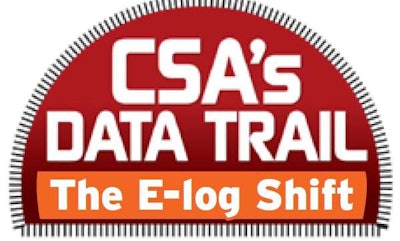 Access interactive map displays of inspection-intensity and violation-category leaders among state enforcement departments, based on calendar 2017 data, in Overdrive’s annual CSA’s Data Trail update of enforcement trends via OverdriveOnline.com/csa. You also can download a report showing rankings in the categories among the 48 continental states. Unless otherwise noted, all data within this report is from the federal MCMIS database and mined by Overdrive and sister company RigDig Business Intelligence.
Access interactive map displays of inspection-intensity and violation-category leaders among state enforcement departments, based on calendar 2017 data, in Overdrive’s annual CSA’s Data Trail update of enforcement trends via OverdriveOnline.com/csa. You also can download a report showing rankings in the categories among the 48 continental states. Unless otherwise noted, all data within this report is from the federal MCMIS database and mined by Overdrive and sister company RigDig Business Intelligence.The inspecting officer “looks at my ELD, and he said, ‘This thing’s not even connected,’ ” Hose recalls. The log showed a further malfunction event that Hose had yet to notice, incurred en route that morning. “I couldn’t give a good explanation for it, and it made me look really bad.” The officer “just assumed it was me rolling down the road without using the ELD.”
The out-of-service order with this false log violation was the last straw for Hose as far as concerned One20. Around the time of the F-ELD’s planned shutdown on June 18, he switched to the BigRoad provider with help of the National Association of Small Trucking Companies. He’s not experienced similar issues to date.
Lt. Kevin Kelley of the Missouri State Highway Patrol notes that inspectors have certainly “seen some issues with ELDs and malfunctions, but it has gotten better since the mandate went into effect.”
As regards Hose’s situation and the false-log violation, “if the ELD did not accurately reflect what the driver did for that day and the driver could not articulate his side of the situation or definitively show the ELD was malfunctioning,” Kelley adds, “then the officer would be correct in citing the violation based on the info he/she had at the time of the stop.”
The “false log” violation – typically written under the 395.8(e) code – also was the one incurred by a driver quoted anonymously in the June Overdrive. When the driver was stopped in traffic, he said, “the ELD changed automatically to on-duty not-driving.”
When the truck moved again, it changed back to driving, but when the hauler was stopped by law enforcement a few hours down the road, that switch netted him a false log violation, often accompanied, as Hose’s case shows, with 10 hours out of service.
Over the entire for-hire population this year, false-log violations are way down. They’re on track to come in at more than 50 percent less than 2017’s total 38,000-plus violations. A closer look at the false-log violation by carrier size, however, shows 1-4-truck fleets’ share of the total rising for the first time in the last five years to nearly 28.3 percent, more closely reflecting the broader trend in HOS violations.
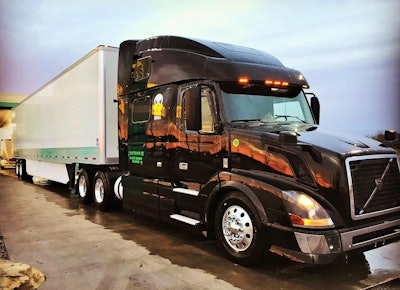 Owner-operator Jon Hose, who runs this 2014 Volvo, holds a technical degree and for a time aspired to a master’s in data science. He believes that if he experienced difficulty explaining his ELD’s technical malfunction to a roadside officer, hoping for some leniency, as detailed in this story, he can only imagine what operators of less technical experience are going through. “I personally could not decipher, a large portion of the time, what exactly was wrong with my ELD,” he says of its many issues.
Owner-operator Jon Hose, who runs this 2014 Volvo, holds a technical degree and for a time aspired to a master’s in data science. He believes that if he experienced difficulty explaining his ELD’s technical malfunction to a roadside officer, hoping for some leniency, as detailed in this story, he can only imagine what operators of less technical experience are going through. “I personally could not decipher, a large portion of the time, what exactly was wrong with my ELD,” he says of its many issues.Kelley noted that owner-operators in a situation like Hose’s might resolve it if they can clearly show an ELD experienced a malfunction that caused their log to misrepresent their day. This may not be possible on the scene but can be done via FMCSA’s DataQs system with a review and follow-on investigation by federal and state officials. Also, Kelley says, “It would be nice if the vendor could verify the malfunction” by phone on the spot, or later as part of a DataQs challenge.
If Hose’s experience is any indication, as ELD providers with clear technical issues or inadequate customer support either solve the issues or leave the ELD market, violation percentages for the smallest operators should improve.
But that doesn’t change the lingering blemished record for operators such as Hose. His measure in the Hours of Service Compliance category of the CSA program shot up from 0 to 9 with the single false-log violation. He’s not sure where that might have put his percentile ranking as a one-truck operator, but as past reporting shows, single violations can have dramatic effects on scores in today’s iteration of the CSA system. Such rankings, though, have been diluted in importance for carriers in the wake of congressional action that put CSA percentiles behind a veil for the general public, including freight partners.
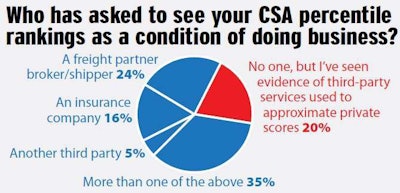 DO CSA SCORES STILL MATTER? | These partial results show the distribution of answers to the question that were affirmative on whether scores were actually being requested. Not shown, but a significant result from the broader poll: More than half of independent owner-operator respondents reported never having had their CSA scores requested by any party. “Brokers do inquire about CSA scores,” says owner-operator Jon Hose, who’s experienced that criteria being used to choose a carrier. The sentiment reflects the largest share seen in this summer polling about the continuing bite of CSA percentile rankings.
DO CSA SCORES STILL MATTER? | These partial results show the distribution of answers to the question that were affirmative on whether scores were actually being requested. Not shown, but a significant result from the broader poll: More than half of independent owner-operator respondents reported never having had their CSA scores requested by any party. “Brokers do inquire about CSA scores,” says owner-operator Jon Hose, who’s experienced that criteria being used to choose a carrier. The sentiment reflects the largest share seen in this summer polling about the continuing bite of CSA percentile rankings.There’s evidence the dilution is less than complete, however. Since the pulling of public category percentile rankings in late 2015, and in the two years since Overdrive readers were surveyed on whether a private party had required sharing of operators’ private scores as a condition of doing business, more readers with authority have had it happen, based on recent polling.
Still, slightly more than half of independents with authority reported not having to share their scores. Among those who did, the largest share reported a freight broker or shipper requesting them. For those readers, avoiding ELD violations of the kind that snared Hose might hold the most import for their success.
Next in this series: More states shift focus to hours-, ELD-related violations



